In today’s fast-paced world, having a peaceful living space is more important than ever. A relaxation sanctuary at home can be a haven for mental well-being and relaxation.
A well-designed zen home decor can transform any room into a calming oasis. By incorporating elements of nature and minimalism, you can create a serene atmosphere that promotes relaxation and reduces stress.
This article will provide expert tips on how to achieve serenity at home by designing a Zen space that fosters relaxation and calmness.
Key Takeaways
- Understand the importance of a peaceful living space for mental well-being.
- Learn how to incorporate elements of nature into your zen home decor.
- Discover the benefits of minimalism in creating a relaxation sanctuary.
- Get expert tips on designing a Zen space that promotes relaxation.
- Find out how to reduce stress and achieve serenity at home.
Understanding the Philosophy of Zen Design
Zen design is more than just a style; it’s a way of creating a mindful interior design that fosters a calming home environment. At its core, Zen design is inspired by traditional Japanese Zen principles, which emphasize simplicity, balance, and mindfulness.
The Origins and Principles of Zen Philosophy
The origins of Zen philosophy date back to ancient China and Japan, where it evolved as a school of Mahayana Buddhism. Zen emphasizes the attainment of enlightenment through meditation and the cultivation of mindfulness. In the context of design, Zen principles translate into a focus on simplicity, natural materials, and a connection to nature.
“Simplicity is the ultimate form of sophistication.”
How Zen Aesthetics Translate to Modern Home Design
In modern home design, Zen aesthetics are applied through the use of minimal ornamentation, neutral color palettes, and an emphasis on natural light. The goal is to create a sense of calm and serenity, allowing inhabitants to disconnect from the stresses of everyday life.
Benefits of Living in a Zen-Inspired Environment
Living in a Zen-inspired environment can have numerous benefits, including reduced stress levels, improved mental clarity, and a greater sense of well-being. By incorporating Zen principles into your home design, you can create a sanctuary that promotes relaxation and mindfulness.
Assessing Your Space: The First Step Toward Tranquility
To achieve tranquility at home, it’s essential to first identify the stress-inducing elements in your current space. This initial assessment is crucial in creating a serene home environment that fosters relaxation and calmness.
Identifying Stress-Inducing Elements in Your Current Space
Begin by walking through your home and noting areas that feel cluttered, chaotic, or uncomfortable. Clutter is a significant stress inducer, so pay particular attention to areas with excessive items. Consider the layout and how it affects the flow of energy in your home.
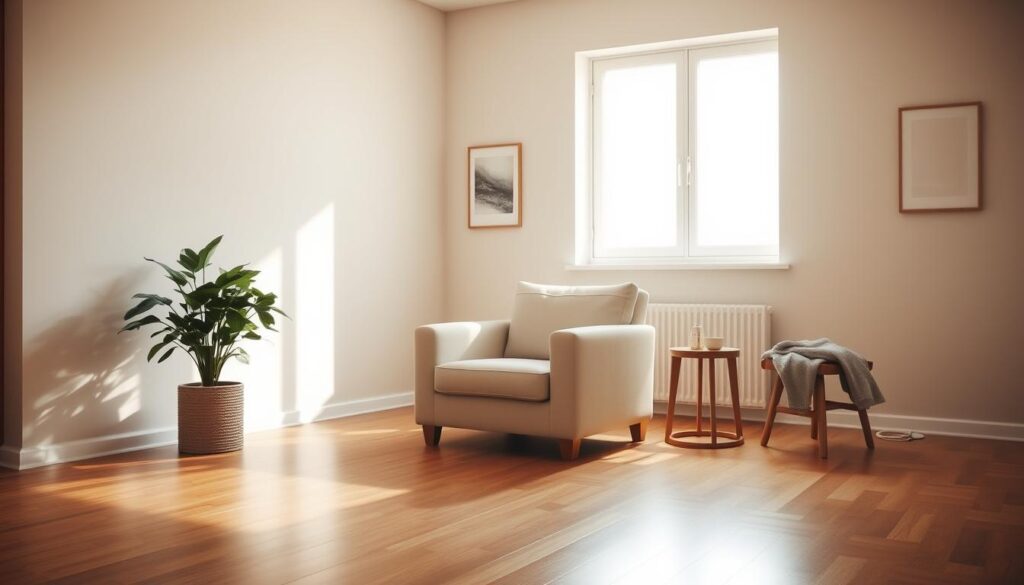
Setting Intentions for Your Zen Transformation
Once you’ve identified the stress-inducing elements, it’s time to set clear intentions for your Zen transformation. Ask yourself what you want to achieve with your new space. Do you want a relaxation sanctuary or a serene home that promotes well-being? Establishing your goals will guide your transformation process.
Creating a Realistic Transformation Plan
With your intentions set, create a realistic plan to achieve your desired Zen space. This might involve decluttering, rearranging furniture, or incorporating natural elements. Consider the following steps:
- Decluttering: Remove unnecessary items that cause stress.
- Rearranging: Improve the flow of energy by rearranging furniture.
- Incorporating Nature: Add plants or natural elements to enhance serenity.
| Step | Action | Benefit |
|---|---|---|
| 1 | Decluttering | Reduces stress and improves focus |
| 2 | Rearranging Furniture | Enhances the flow of energy |
| 3 | Incorporating Natural Elements | Promotes a sense of calm and well-being |
“The space in which we live should be for the person who inhabits it, and not the person for the space.”
By following these steps and maintaining a clear intention, you can create a Zen space that brings tranquility and serenity into your home.
Creating a Zen Space: Tranquility at Home
Creating a Zen space at home is about more than just aesthetics; it’s about crafting an environment that promotes tranquility and well-being. A Zen-inspired home is designed to be a sanctuary that nurtures both body and mind.
Essential Elements of a Zen-Inspired Space
A Zen-inspired space incorporates natural elements, minimal decor, and soft lighting to create a peaceful living space. Natural materials such as wood, stone, and bamboo are commonly used to bring warmth and texture to the space.
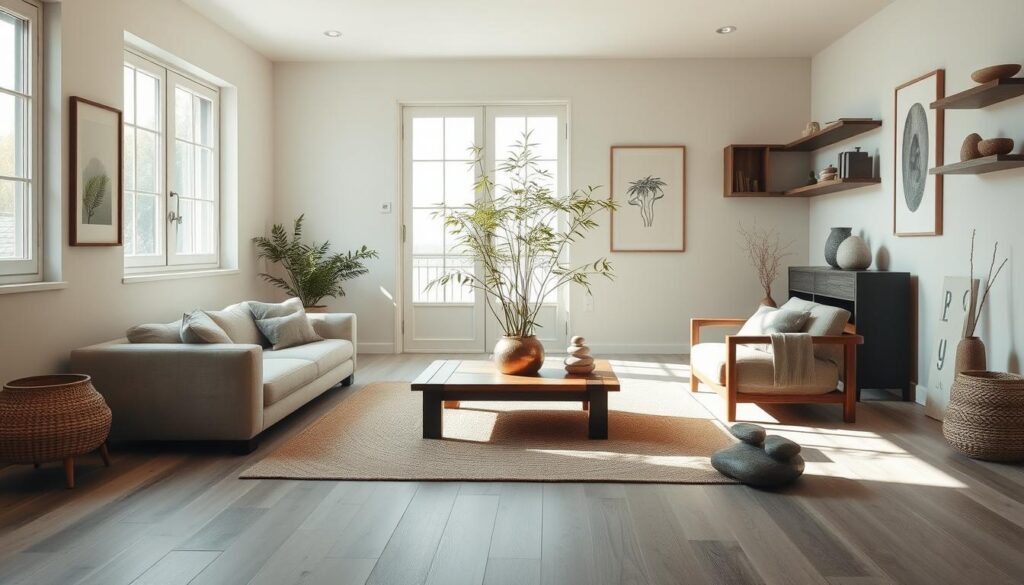
Balancing Form and Function in Every Room
Balancing form and function is crucial in creating a tranquil home oasis. This involves selecting furniture that is not only aesthetically pleasing but also serves a practical purpose. Multi-functional pieces can help reduce clutter and enhance the sense of calm.
Adapting Zen Principles to Different Living Situations
Adapting Zen principles to different living situations requires flexibility and creativity. Whether you live in a small apartment or a spacious house, you can apply Zen design principles to create a serene environment that suits your lifestyle.
By incorporating these elements and principles, you can create a Zen-inspired space that is both beautiful and functional, providing a peaceful retreat from the stresses of everyday life.
The Power of Minimalism in Zen Design
A minimalist approach is fundamental to Zen design, enabling individuals to create a serene and tranquil space at home. By embracing minimalism, one can foster a calming home environment that promotes relaxation and reduces stress.
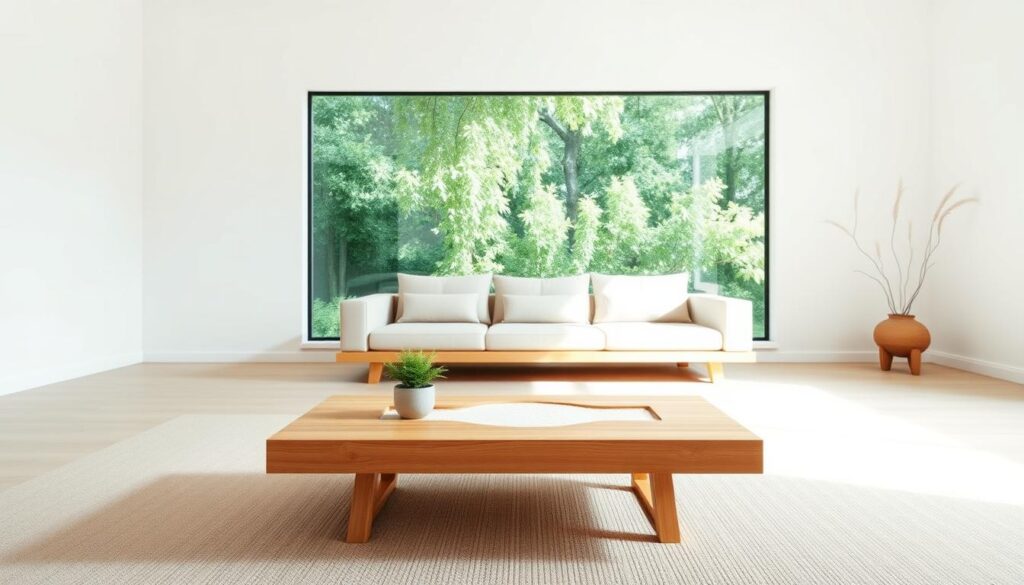
Practical Decluttering Strategies for a Peaceful Environment
Decluttering is a crucial step in achieving a Zen-inspired space. Start by removing items that are no longer needed or that cause clutter. Consider adopting a minimalist mindset that values simplicity and clarity. Sorting items into categories and letting go of duplicates or unnecessary items can simplify the decluttering process.
Regularly scheduled decluttering sessions can help maintain a clutter-free environment, contributing to a sense of serenity at home.
Quality Over Quantity: Choosing Meaningful Items
In a Zen-inspired home, the focus is on quality over quantity. Choosing items that hold personal significance or serve a purpose can enhance the sense of calm. Mindful interior design encourages the selection of a few, meaningful pieces rather than numerous, less significant items.
Storage Solutions That Maintain Visual Calm
Effective storage solutions are essential for maintaining visual calm in a Zen-designed space. Using natural materials and simple designs for storage can help keep clutter at bay while contributing to the overall aesthetic of serenity.
By incorporating these principles, individuals can create a peaceful and calming home environment that embodies the essence of Zen design.
Color Psychology for Serenity
Colors have a profound impact on our mood and environment, making them crucial in crafting a zen-inspired living space. The right color palette can promote relaxation and reduce stress, creating a peaceful ambiance that soothes the mind and body.
Calming Color Palettes for Different Rooms
Different rooms serve different purposes, and the color palette should reflect this. For instance, a bedroom benefits from soft, muted tones like light blue or pale green, which encourage restful sleep. In contrast, a living room can incorporate warmer neutrals that foster a sense of community and relaxation.
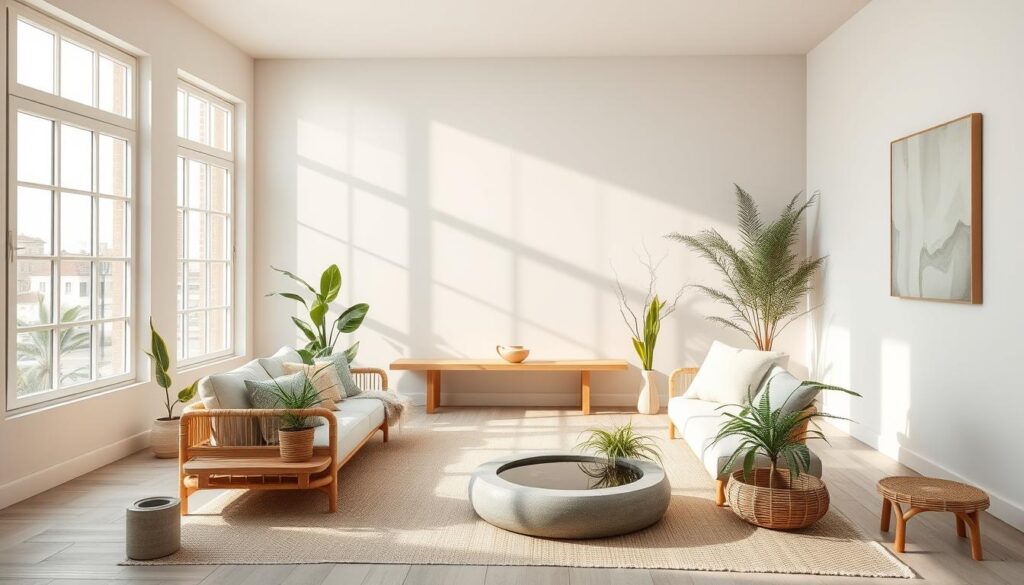
Using Neutral Tones as a Foundation
Neutral tones such as beige, cream, and soft gray provide a calm foundation for any room. These colors are versatile and can be paired with a variety of accent colors to add depth without overwhelming the senses.
Incorporating Subtle Natural Accents
Incorporating subtle natural accents like earthy tones or soft pastels can enhance the serene atmosphere of your home. These colors can be introduced through furniture, artwork, or decorative items, adding a touch of nature indoors.
| Room | Recommended Colors | Effect |
|---|---|---|
| Bedroom | Soft blues, pale greens | Promotes restful sleep |
| Living Room | Warm neutrals, earthy tones | Fosters relaxation and community |
Furniture Selection and Arrangement for Flow
Achieving zen home decor is not just about minimalism, but also about selecting and arranging furniture mindfully. The right furniture can enhance the flow of your space, creating a tranquil home oasis.
Choosing Low-Profile, Natural Material Furniture
Opting for low-profile furniture made from natural materials like wood or bamboo can significantly contribute to a serene atmosphere. These materials bring warmth and texture to your space, promoting a sense of calm. Natural materials are not only aesthetically pleasing but also tend to be more durable.
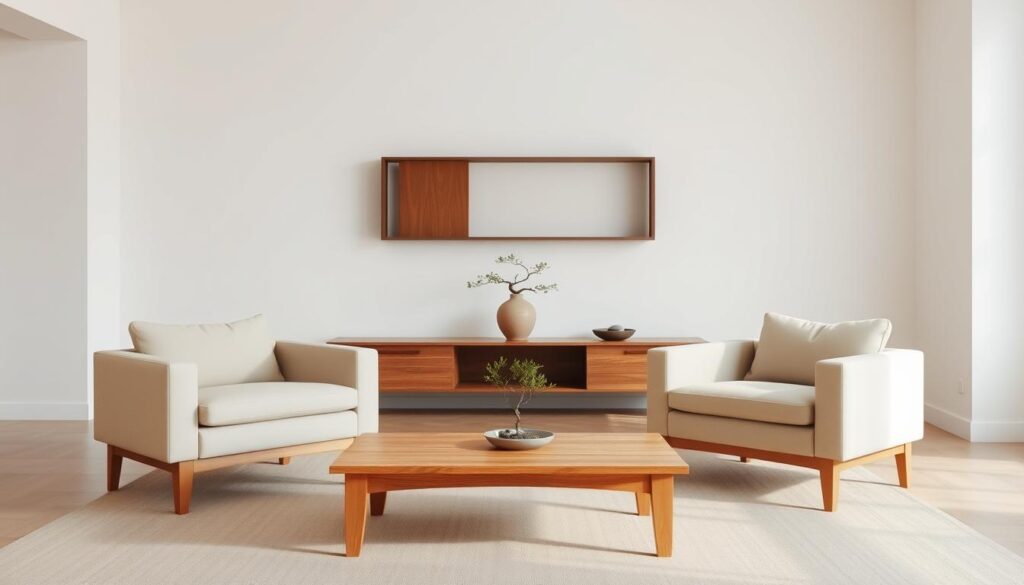
Creating Space and Movement with Thoughtful Placement
The arrangement of furniture is crucial for maintaining flow. Placing furniture in a way that creates clear pathways and doesn’t obstruct movement can make your space feel more spacious and relaxing. Consider the traffic paths in your home and arrange furniture to facilitate easy navigation.
Multi-Functional Pieces That Reduce Visual Clutter
Using multi-functional furniture is a practical way to reduce visual clutter, contributing to a more zen-like environment. For example, a storage ottoman can serve as both a seat and a storage unit, minimizing the need for additional pieces.
| Furniture Type | Benefits | Examples |
|---|---|---|
| Low-Profile | Creates a sense of openness, promotes flow | Low-seating sofas, minimalist coffee tables |
| Natural Materials | Adds warmth, durability | Wooden furniture, bamboo decor |
| Multi-Functional | Reduces clutter, increases functionality | Storage ottomans, sofa beds |
Incorporating Natural Elements
Nature has a way of calming the mind, and incorporating its elements into your home can be transformative. By bringing the outdoors in, you can create a serene home environment that promotes relaxation and tranquility.
Indoor Plants and Their Calming Effects
Indoor plants are not just decorative; they have a profound impact on our well-being. They help purify the air, reduce stress, and promote a sense of calm. Some of the most calming plants include Lavender, Snake Plant, and Peace Lily. Incorporating these into your zen home decor can significantly enhance the calming atmosphere.
Water Features for Visual and Auditory Tranquility
The sound of water is inherently calming. Incorporating a water feature, such as a small fountain, can add a soothing auditory element to your space. The visual aspect of water features also contributes to a calming home environment, creating a sense of serenity.
Stone, Wood, and Bamboo Accents
Natural materials like stone, wood, and bamboo bring warmth and texture to your space. Using these materials for accents or furniture can enhance the zen feel of your home. For example, a wooden wall or bamboo blinds can add a natural, earthy element.
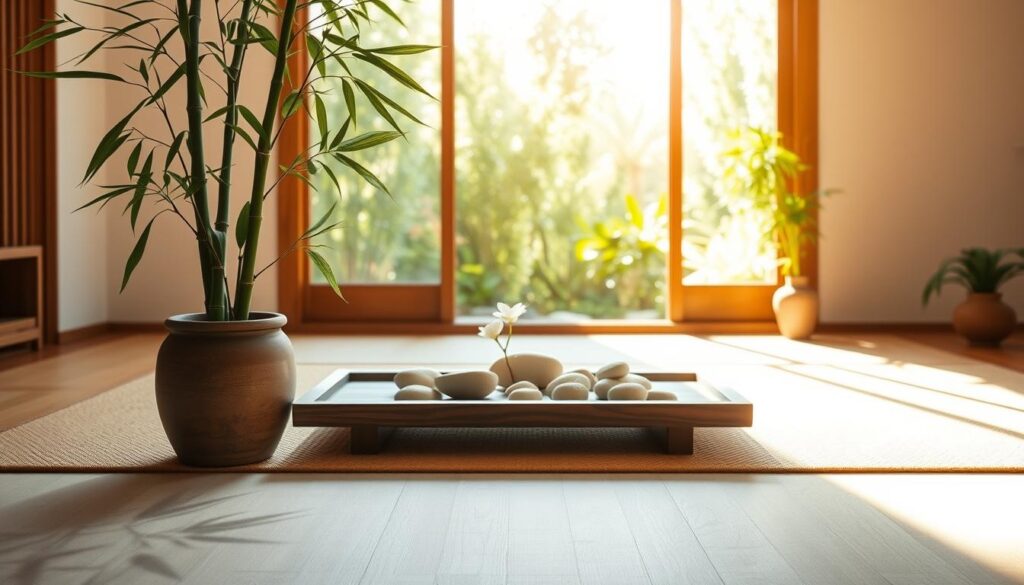
By incorporating these natural elements, you can create a truly serene home that embodies the principles of zen home decor. It’s about creating a space that feels connected to nature and promotes a sense of calm and well-being.
Creating a Dedicated Meditation or Relaxation Area
To cultivate a sense of serenity at home, it’s essential to create a peaceful retreat that serves as a relaxation sanctuary. This dedicated space can be a powerful tool for reducing stress and promoting mental well-being.
Selecting the Ideal Location in Your Home
When choosing a location for your meditation or relaxation area, consider a spot that is quiet and free from distractions. Ideally, this space should be located in a area with minimal foot traffic and noise.
Essential Elements for a Meditation Space
A peaceful living space requires careful consideration of the elements that promote relaxation. Some essential elements include comfortable seating, calming colors, and natural elements such as plants or a water feature.
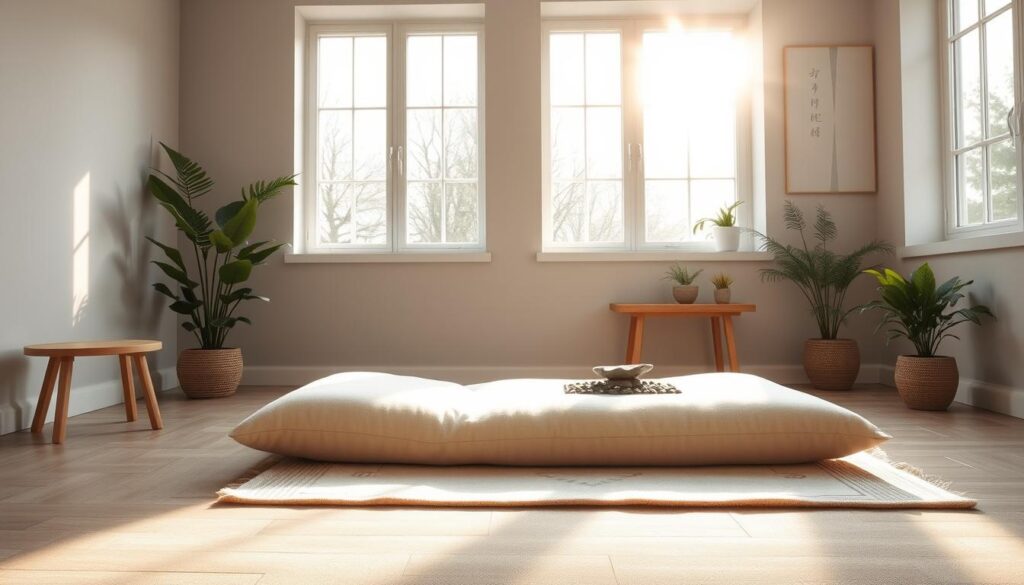
Personalizing Your Sanctuary
To make your meditation or relaxation area truly special, incorporate personal touches that reflect your personality and style. This could include meaningful artwork, soothing textiles, or calming scents, all of which contribute to a mindful interior design.
By carefully selecting the location, incorporating essential elements, and personalizing your space, you can create a relaxation sanctuary that nurtures your mind, body, and spirit.
Lighting Your Zen Sanctuary
The right lighting can transform your space into a tranquil oasis, embodying the principles of Zen philosophy. Lighting is not just a practical necessity; it’s a crucial element in creating a calming home environment that fosters relaxation and mindfulness.
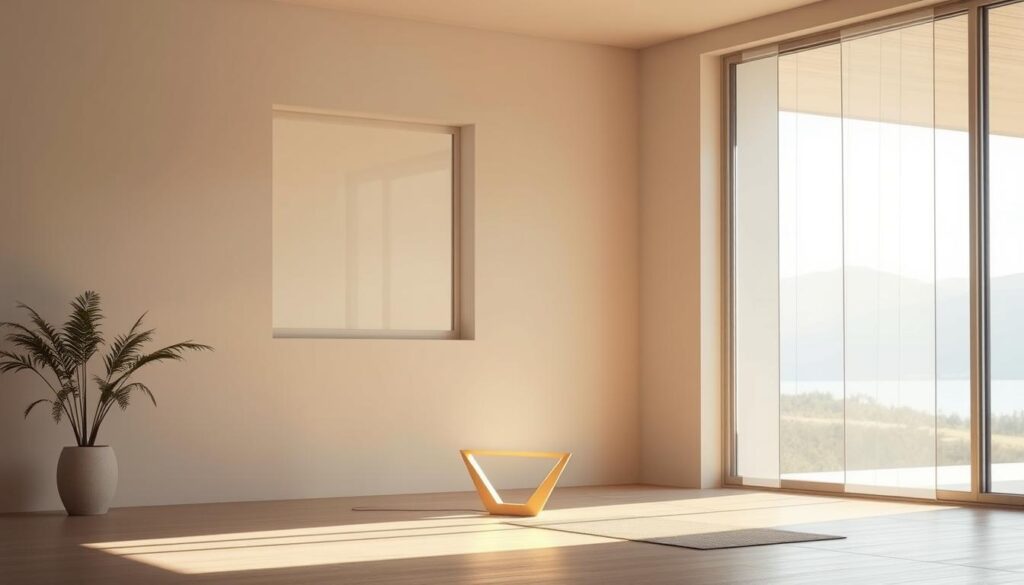
Maximizing and Softening Natural Light
Natural light is a key component of Zen-inspired living spaces. To maximize natural light, use sheer curtains or blinds that can be easily adjusted to control the amount of light entering the room. This approach not only brightens the space but also softens the light, creating a warm and inviting atmosphere.
As the renowned interior designer, Marc Ecko, once said, “Light is a powerful tool in interior design. It can make or break the ambiance of a room.” By maximizing and softening natural light, you can create a serene home that feels connected to the outdoors.
Layered, Ambient Lighting Solutions
For times when natural light is not available, layered, ambient lighting solutions can replicate the warmth and coziness of daylight. This involves using a combination of light sources, such as overhead lighting, table lamps, and floor lamps, to create a layered effect. The goal is to achieve a balanced lighting scheme that is both functional and aesthetically pleasing.
- Use dimmer switches to adjust the light intensity according to the time of day and activity.
- Select light fixtures that are minimalist in design to maintain the Zen aesthetic.
- Incorporate LED lights or warm-toned bulbs to create a cozy ambiance.
Candlelight and Its Role in Zen Spaces
Candlelight is another element that can enhance the serenity of a Zen sanctuary. The soft, flickering flame of a candle can create a sense of calm and tranquility, making it an ideal addition to a meditation or relaxation area. When using candles, ensure they are placed safely and are of high quality to avoid any distractions.
“The flame of a candle is a reminder that even in the darkest moments, there is always light to be found.”
By thoughtfully incorporating these lighting strategies, you can create a serene home that embodies the principles of Zen design, providing a peaceful retreat from the stresses of everyday life.
Creating a Multi-Sensory Zen Experience
To achieve a state of profound calm at home, it’s essential to consider not just what you see, but also what you hear, smell, and feel. A multi-sensory Zen experience envelops you in tranquility, engaging your senses to foster deep relaxation and mindfulness.
Sound Elements: From Silence to Gentle Acoustics
Sound plays a crucial role in setting the tone for a serene environment. While silence can be golden, gentle acoustics can also enhance the Zen experience. Consider incorporating soft music or nature sounds, such as rain or ocean waves, to create a calming ambiance.
- Use a sound machine or a mobile app to introduce gentle sounds.
- Incorporate a small water feature for the soothing sound of flowing water.
- Hang wind chimes to create soft, melodious tones.
Aromatherapy for Different Moods and Spaces
Aromatherapy is a powerful tool for influencing mood and atmosphere. Different scents can promote relaxation, invigoration, or focus. Essential oils such as lavender, chamomile, and sandalwood are known for their calming properties.
| Mood/Space | Recommended Essential Oil |
|---|---|
| Relaxation | Lavender, Chamomile |
| Focus/Study | Peppermint, Rosemary |
| Calm/Meditation | Sandalwood, Frankincense |
Tactile Considerations: Textures That Promote Calm
The sense of touch is often overlooked but is vital in creating a cozy and inviting space. Incorporating a variety of textures can enhance the sensory experience. Soft fabrics, natural materials, and smooth surfaces can all contribute to a calming atmosphere.
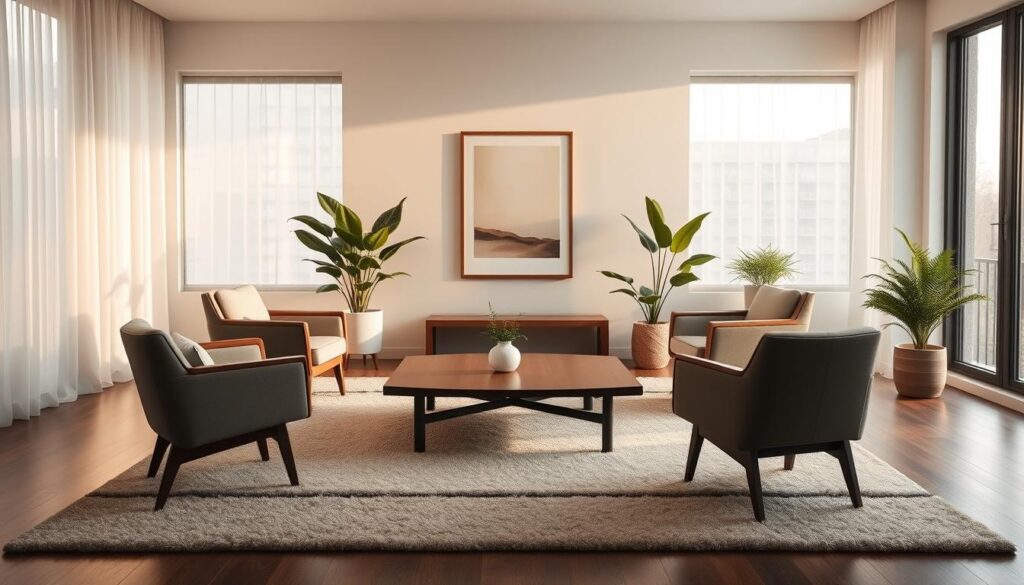
By thoughtfully integrating sound elements, aromatherapy, and tactile considerations, you can create a truly multi-sensory Zen experience in your home, promoting relaxation and well-being.
Conclusion: Living Mindfully in Your Zen Space
Creating a zen home decor is not just about aesthetics; it’s about cultivating a serene home environment that promotes relaxation and mindfulness. By applying the principles discussed in this article, you can transform your living space into a tranquil oasis that nurtures your well-being.
Living mindfully in a zen space means embracing simplicity, clarity, and a deep connection to nature. As you incorporate natural elements, minimalism, and thoughtful design, you’ll find that your home becomes a sanctuary that calms the mind and soothes the soul.
By creating a zen space: tranquility at home, you’ll experience a profound impact on your daily life. You’ll be better equipped to handle stress, and your mental clarity will improve. Embracing this serene home environment will allow you to live more intentionally, fostering a deeper sense of calm and well-being.



